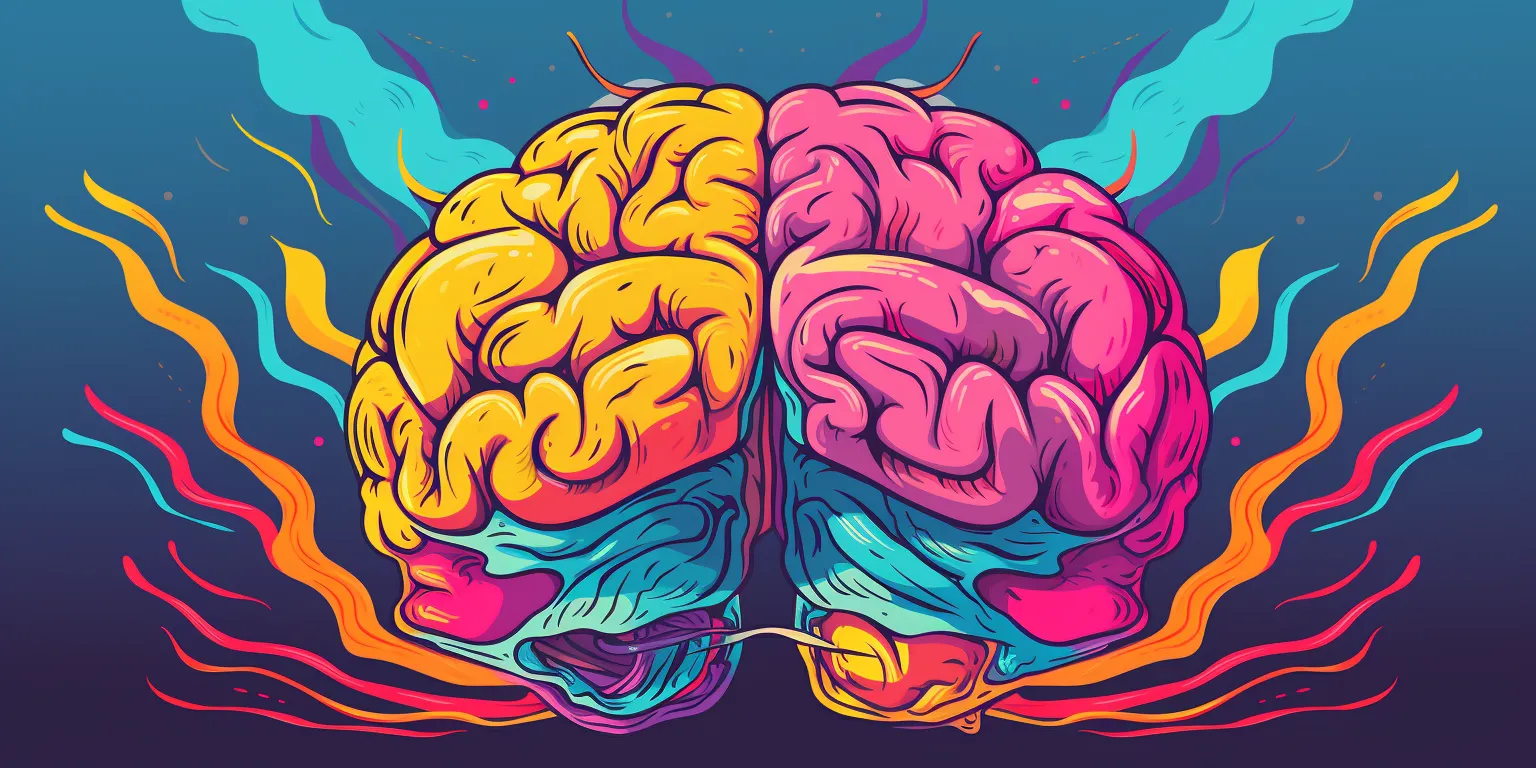Psychedelic trips revealing who you really are is a pretty sexy concept. And there are a number of ways to investigate what the nature of your trip may be “telling you,” or, in other words, what you may be attempting to communicate to yourself.
From a scientific perspective, we don’t conclusively know what (if any) self-reflected meaning is attached to a psychedelic trip. However, if we were to start digging into what a psychedelic trip could say about you, the first place we would explore is undoubtedly the wild world of psychoanalysis.
Psychoanalysis and the Psychedelic Experience

You’ve undoubtedly heard of psychoanalysis, and if you have, the name Sigmund Freud should definitely ring a bell.
Some believe the closest we can get to determining what a trip means to a person is through psychoanalysis, a technique that aims to tap into your “unconscious mind.” Determining one’s personality or inner beliefs based on how one interacts or perceives objects, relationships, and the environment they inhabit isn’t a new phenomenon. Psychoanalysis has been around since 1896, an invention by physiologist Sigmund Freud, as mentioned. Within a few years (and with the help of Carl Jung), its popularity made it a dominant force in clinical psychology. In less than a decade, it became the single defining practice for therapeutic psychologists.(1, 2)
Keep Up with Psychedelic Trends
Don’t miss the latest psychedelic news, events, companies, and more.
We respect and protect your privacy. By subscribing your info will be subject to our privacy policy. Unsubscribe easily at any time
As the sophistication of the field of psychology progressed, new theories replaced older ones – and a debate arose about the efficacy of psychoanalysis in and of itself.(3)
Freud’s Influence on Psychedelic Trips
Although it’s been over fifty years, the remnants of Freudian concepts still remain in psychedelic science. His idea of “self” and “ego” are used with some frequency, for example..(4)
You’re likely familiar, but I’ll offer some simple explanations for those who aren’t. From the Freudian perspective, the ego is the “rational” side of the self. The part that is meant to keep us balanced between ethics/morals and our primal instinct. That is, of course, just a theory.
The use of the word “ego” is frequently used in psychedelics with the notion of “ego dissolution.” In this sense, the ego means something slightly different from how Freud used it. It is, ostensibly, the human personality as distinct, and disconnected from, other people, nature, animals, and the universe itself. (Freudian “ego” is more distinct and related to the idea of a “rational mind.”)
As such, the idea of ego dissolution is the sense that one disperses into a greater “something” while under the influence of psychedelics. In other words, the “self” as we normally understand it dissolves, and the individual becomes “one” with everything, therefore losing the distinct personality features that one typically uses define who they are in the world. It’s a state that many psychonauts aspire to achieve, and the concept has also crept up in how psychopharmacologists evaluate and measure psychedelic trips.
The Five-Dimensional Altered States of Consciousness Scale (5D-ASC) is a self-administered test used to analyze a psychedelic experience’s subjective effects. Among the many dimensions this scale covers, one particular measurement called “oceanic boundlessness” is rooted in the idea of the dissolution of the “ego.”
Keep Up with Psychedelic Trends
Don’t miss the latest psychedelic news, events, companies, and more.
We respect and protect your privacy. By subscribing your info will be subject to our privacy policy. Unsubscribe easily at any time
Essentially what you see and experience while you’re on a psychedelic is the first time anyone in humanity has experienced it and will most likely be the last.
Ego (and lack thereof) has become so closely associated with describing the psychedelic experience that, for some, explicitly detailing a trip without using the word ego is impossible. We might benefit from a new path of understanding the psychedelic experience and how it relates to a person based solely on perception and subjective experience, rather than how our feelings translate to deeply rooted personality traits.
Interested in Learning How You Can Have a Safe Psychedelic Trip?
Set, Setting, and Safety: 10 Tips for a Positive Psychedelic Experience
What Your Psychedelic Trips Might Tell You About Yourself
The psychedelic experience is almost entirely focused on the subjective experience, which is an incredibly unique blend of perceptual modalities that are altered while tripping. It makes psychedelics a wholly unique experience that can’t be exchanged (or validated) with another person’s perception. Essentially, what you see and experience while you’re on a psychedelic is the first time anyone in humanity has experienced it and will most likely be the last. Such a personal experience should hold an enormous amount of information about ourselves.
However, it’s also possible that your trip is revealing a great deal about the facilitator or psychedelic therapist who administered the substance.
The one thing that is paramount to understand is that in nearly all psychedelic experiences the level of suggestibility increases. This is related not to one internal process, but many that contribute to increased levels of suggestibility. In fact, the leading theory of brain augmentation while under psychedelics implements this level of suggestibility at its core. REBUS, or relaxed beliefs under psychedelics, is a theory created by neuroscientist Robin Carhart-Harris. It states that psychedelics alter how humans process hierarchical information. In short, perceptual information, how we perceive the world around us (sight, sound, smell… etc) enters the brain and undergoes a hierarchical categorization of information.(5)
In a sense, setting one’s intention is a tool to construct the architecture within a trip. Almost like creating the constructs or blueprint for the psychedelic experience to take place in.
In the REBUS model of psychedelic modulation, these hierarchical levels become less structured, and information may reside in a hierarchical area it’s not designated for. This less-ordered structure, or relaxed beliefs, may be responsible for the “trip” during psychedelics and may leave people with an increased (but temporary) sense of suggestibility.
The Influence of Integration on Psychedelic Trips
Since psychedelics appear to produce a temporary system of “relaxed beliefs” while tripping, the idea of integration becomes paramount. A term once used solely for psychedelic therapists, integration has now become a mainstay of the psychedelic field. In indigenous cultures, this integration process usually comes in the form of group dosages, usually in ceremonial settings accompanied by chants, songs, and “icaros.” Within psychedelic therapy, integration may come as a guided discussion that happens during and toward the end of a psychedelic experience.
The person tripping has the opportunity to discuss personal, and often existential issues they may be grappling with. Psychedelic therapists often implore individuals to continue to express what they’re feeling and how other scenarios in their life may be affected or resolved with the new insights they are receiving through psychedelics. In both ceremonial and therapeutic contexts, integration aims to ensure a person will implement newly-acquired knowledge and feelings they received while on psychedelics. Ultimately this method has an enormous impact on what your trip says about you – but what about before the trip? (6)
One’s own environment, the place they take the psychedelic in, is ultimately a key factor in the experience.
The Influence of Intent on a Psychedelic Trip
Undoubtedly you’ve heard of the notion of setting your intentions prior to a psychedelic experience. This is essentially the belief that before one’s trip it’s important to set forth a cognitive game plan filled with questions and desires that one wants to see fulfilled during the experience. Setting one’s intention can be anything from ensuring you’re emotionally capable of handling the experience to more specific things like how to better one’s relationship with their partner or family member. In more goal-oriented sessions, one may ask for the ability to solve a difficult problem at their job, or to explore some new idea following their psychedelic experience. In a sense, setting one’s intention is a tool to construct the architecture within a trip. Almost like creating the constructs or blueprint for the psychedelic experience to take place in.
So perhaps the extent to which a person can draw meaning about themselves from a trip partially depends on the intention one frames the trip within. Constraints can be beneficial in narrowing a desired outcome – go into a trip believing that you will have a better relationship with your adopted kitten, and most likely, you will emerge from your experience with a better relationship with that adopted kitten (or really any kitten depending on the dosage).
In clinical research, the notion of having a certain belief or expectation of a desired outcome is called the “expectancy effect.” The expectancy effect is an obstacle that science investigators must overcome when conducting human psychedelic research. For example, suppose a person enrolls to be a subject in a study that looks at how MDMA decreases depression after administration. In that case, that person will be more inclined to self-report they have a decrease in depression simply by them having the understanding that MDMA has the potential to decrease depression.(7)
In a sense, intention, and integration are like strong suggestions that influence the variability of one’s own personal connection to their psychedelic trip. Having these suggestions and expectations come from a highly-skilled therapist, or tripsitter, could expedite the information that one can learn from themselves – as with any therapist or psychologist. It’s possible that the introduction of psychedelics only serves to catalyze, expedite, or enhance this process of self-actualization. It’s also important to note that intention setting and integration don’t necessarily have to be established by a certified or trained therapist. In a ceremonial setting, this can be established by the trip facilitator – otherwise known as one of the most misused terms in the psychedelic field: a shaman.
However, the intent of one taking a psychedelic and the psychological integration aren’t the only factors that may augment a psychedelic trip. One’s own environment, the place they take the psychedelic in, is ultimately a key factor in the experience.
Learn More About Setting An Intent For Your First Psychedelic Experience:
How to Prepare for Your First Psychedelic Trip in 5 Easy Steps You Need to Know
Setting vs. Self Within the Psychedelic Experience

A brilliantly simple concept constructed by Timothy Leary in the late 1960s has become a cornerstone in establishing the context of nearly all psychedelic experiences. It’s the idea that setting: the environment and things within it play an enormously influential role in what one will normally extract from a psychedelic experience.
Within psychedelics, there are generally two settings in which people are given these substances, and it’s believed both have a profound impact on the experiential nature of the trip. The first category is “naturalistic settings,” which is how one normally takes psychedelics. This can range from dropping LSD in your friend’s basement to being at the top of the Andes mountains purging from an ayahuasca ceremony. Essentially naturalistic settings are any setting or environment that one would normally take psychedelics.
The second category is the clinical setting of psychedelic administration. This setting is critical for scientific research and is the preferred method for most psychopharmacology and neuroscientific studies. The reason is that researchers are allowed to control external conditions and do their best to isolate the subject with only the psychedelic (along with whatever cognitive and/or physical task to assess whatever thing they’re researching). It’s all about reducing the number of external factors to increase the study’s internal validity. In fact, it’s a practice that has allowed science to make an array of discoveries about behavior, the brain, and psychedelics. However, not everyone has the same reaction regarding being in a clinical environment.
There is also something called “whitecoat hypertension,” which is when a person has an elevated physiological response to being in clinical settings, including increased heart rate, blood pressure, and anxiety. Normally in screenings for clinical studies, whitecoat hypertension can be identified, and these potential subjects would be expunged from the study. This is a process that happens quite often in the arduous selection process of psychedelic studies.
What Your Psychedelic Visual Experience Says About You
While experiencing visual disturbances and hallucinations is one of the most distinct attributes after taking an adequate amount of psychedelics, it’s also one of the least researched phenomena. Currently, the vast amount of psychedelic research (and funding) is being distributed to research on how these compounds can serve as therapy for a myriad of maladaptive behaviors like anxiety, depression, PTSD, and addiction. These are all noble pursuits that will ultimately better the human experience – important research that will hopefully be able to alleviate long-held cognitive disorders. However, in this stringent pursuit, science has left out one of the most vital aspects of the psychedelic experience – the trip.(9)
In fact, the idea of the psychedelic trip, which is sensory modalities, like vision and sound, being augmented by substances, is such an afterthought that companies are actively trying to create psychedelic compounds that have no psychedelic effects at all. It’s almost like we forgot the primary reason why most people out there began taking psychedelics at all: to have a trip.
Of course, during an intense psychedelic experience, one may encounter certain things that may be perceived as meaningful. Actually, why even beat around the bush? There’s one thing all psychonauts want to know…
What do the DMT elves tell us about ourselves?
Interested in Learning More About How Psychedelics Work?
Understanding How Psychedelics Work with Dr. Alex Belser
The DMT Elves
DMT elves are a concept made popular by the late ethnobotanist and psychedelic pioneer Terence McKenna. During his lectures across America (all of which you should listen to), he mentioned the concept of DMT elves, creatures he also referred to as “self-transforming machine elves,” that would appear to him during very high doses of DMT. McKenna stated these elves may come from a different dimension unlocked with DMT or even be creatures created entirely of language. Nevertheless, he insisted these entities were very real and that if a person takes DMT in a large dose, they will also be able to encounter these hyperdimensional travelers.(8)
Want to Know What Rick Strassman Thinks About DMT Entities?
Does the Spirit Molecule, DMT, Drive Our Sense of Reality? We Talk with Expert Dr. Rick Strassman
Surprisingly, my stance on this apparent phenomenon is controversial – probably because many people really want to believe that interdimensional elves live inside one’s head and only emerge when a person experiences the effects of DMT.
My view is that aliens, elves, and entities (probably) aren’t living in your head or communicating with you from a hyperdimensional portal while you do DMT. Remember, you only know what aliens, elves, and dimensional portals look like because you saw or read it in a work of fiction.
However, appearances of self-transforming machine elves can reveal a great deal about yourself.
For example, seeing elves in your DMT trip could simply mean that you’re familiar with Terence McKenna’s work and that, in the course of listening to him speak over the years, he created an expectation for you actually to visualize the same entities he mentioned while on DMT. Having the subjective experience of a psychedelic influenced by others is not out of the ordinary. As we mentioned earlier, being able to influence and integrate a psychedelic experience is a much-needed field of therapy. Even works of fiction, prior education, and religious/cultural attitudes can greatly influence a trip.
For the sake of argument, what if Terence McKenna saw these elves because everyone that takes DMT sees elves, and everyone that will take DMT in the future will continue to see these strange entities? Does that mean there is, in fact, some hidden dimensional reality that is populated by an entire species of interdimensional beings? Maybe, or maybe not, in an interview with Dr. Alex Belser, he suggests that what we see during a trip may be a reflection of our internal narrative.
Or, perhaps, despite our vast cultural, political, and geographical differences, everyone on this planet is working with pretty much the same neurological hardware in their head. When a powerful psychedelic like DMT is taken, the brain that we all have gets throttled similarly. Similar to how the taste of chocolate cake is sweet to a person in Iceland, Indiana, or India (although the response and interpretation of the flavor profile is also influenced by a whole host of physical, personal, and cultural elements).
Let’s not forget, we’re all the same species. The amount of money a person inherits at birth, or the geographical location a person was born in, does not negate this very basic principle. Therefore if we do, in fact, have a similar neurological response to a psychedelic, like perhaps hallucinating entities and creatures, then this collective cognitive phenomena should do more to bring us together than rip us apart.
The Limitations of Research and the Future of Self-Discovery with Psychedelics
As mentioned in the beginning of this article, estimating any measurement about yourself through a psychedelic experience can be both challenging and complex. Despite the vast strides we’ve seen within psychedelic science over the past 10 years, our understanding of how these substances affect the brain, behavior, and cognition is still relatively new. Between Timothy Leary and Jan Raemakers are decades of missed opportunities science was forced to squander away due to cultural and political attitudes of drugs at the time. Some parts of the world are getting over their draconian attitudes towards psychedelics. While that may be, the research required to have a greater understanding of how a trip relates to you is vast and will require the tireless work of a multitude of scientific disciplines.
Learn About The Science, Uses, and Tips for Using Psychedelics Safely with Our Psychedelic Guides:
LSD, MDMA, Ketamine, Psilocybin, 5-MeO-DMT, Ayahuasca and DMT
Understanding the visual domain of the psychedelic experience is what my neuropsychopharmacology research is focused on at Maastricht University. I believe once we have a more robust understanding of perceptual disturbances and hallucinations while under psychedelics, this seemingly abnormal brain activity can reveal much about how we perceive our universe, and ultimately ourselves. However, this research will not single-handedly solve the puzzle of psychedelics (and these chemicals are still very much a scientific mystery), but if all things go as planned, it will nudge science just a bit closer to understanding what a trip says about the human experience.
Sources

1. Burton, E. S. (2015). Sigmund Freud | Institute of Psychoanalysis. Psychoanalysis.org.uk. https://psychoanalysis.org.uk/our-authors-and-theorists/sigmund-freud
2. Sigmund Freud – Theories, Quotes & Books. (2021, May 3). Biography. https://www.biography.com/scientists/sigmund-freud
3. March 2020, B. P.-L. S. C. 21. (2020). Was Freud right about anything? Livescience.com. https://www.livescience.com/why-freud-was-wrong.htm
4. Crews, F. (2017). Freud: The Making of an Illusion. In Amazon. Metropolitan Books. https://www.amazon.com/Freud-Making-Illusion-Frederick-Crews-ebook/dp/B01NAYNITF
5. Carhart-Harris, R. L., & Friston, K. J. (2019). REBUS and the Anarchic Brain: Toward a Unified Model of the Brain Action of Psychedelics. Pharmacological Reviews, 71(3), 316–344. https://doi.org/10.1124/pr.118.017160
6. Rodríguez Arce, J. M., & Winkelman, M. J. (2021). Psychedelics, Sociality, and Human Evolution. Frontiers in Psychology, 12. https://doi.org/10.3389/fpsyg.2021.729425
7. APA Dictionary of Psychology. (2014). APA Dictionary of Psychology. Apa.org. https://dictionary.apa.org/expectancy-effect
8. History Ends in Green (Terence Mckenna) FULL. (n.d.). Www.youtube.com. Retrieved August 29, 2023, from https://www.youtube.com/watch?v=d5OvtNnmsQs
9. Gregorio, D. D., Aguilar-Valles, A., Preller, K. H., Heifets, B. D., Hibicke, M., Mitchell, J., & Gobbi, G. (2021). Hallucinogens in Mental Health: Preclinical and Clinical Studies on LSD, Psilocybin, MDMA, and Ketamine. Journal of Neuroscience, 41(5), 891–900. https://doi.org/10.1523/JNEUROSCI.1659-20.2020
This material is not intended as a replacement or substitute for any legal or medical advice. Always consult a medical professional about your health needs. Psychedelics are widely illegal in the United States, and readers should always be informed about local, state, and federal regulations regarding psychedelics or other drugs.

 Zeus Tipado
Zeus Tipado